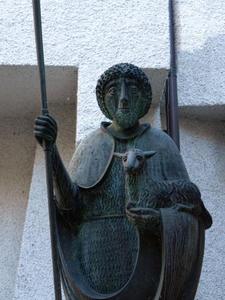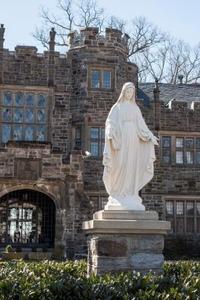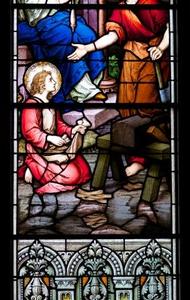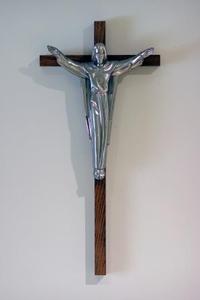The New Shepherds of Catholic Education
By Kelly Medinger
10-02-2014
Maintaining the Catholic identity of schools during transitions to lay leadership
 Then I will give you shepherds after my own heart, who will lead you with knowledge and understanding.
Then I will give you shepherds after my own heart, who will lead you with knowledge and understanding.
~ Jeremiah 3:15
From the first disciples to the present, centuries of men and women have been called to be leaders and teachers of the faith. And while that promise is still being kept today, the face of our shepherds in the Catholic Church is changing – a phenomenon perhaps most apparent in the Catholic schools. No longer are there enough sisters, brothers and priests to lead the schools, so lay men and women are increasingly being sought to fill the positions that religious leaders held in the past.
Background
The halcyon days of religious leadership in schools were in the 1950s and 1960s. “In the 1960s, we had about a 75/25 ratio of religious to lay faculty and staff in the schools. That has declined about 10% every decade since,” shares Sr. Dale McDonald, PBVM, Ph.D., Director of Public Policy and Educational Research at the National Catholic Educational Association. By about 1990, there were just 15% religious in the schools; by 2000 it was down to 7%, and now it is only 3%. “The trend is pretty well established, that the religious are gone from the schools,” Sr. Dale says.
In the Archdiocese of Baltimore in 1998, there were 98 Catholic schools serving 36,000 students. About 170 religious worked at those schools full-time, including 128 sisters and 41 brothers. Fifteen years later, there were only 40 religious at the remaining 70 schools serving 28,000 students. In the future, “there will probably be some religious at the schools, but looking at the demographic data, we expect that there will be less than 2% in 10 years,” proclaims Sr. Dale.
A combination of factors has led to this decline. Two often cited reasons are the reduction in vocations and the aging of existing religious sisters, brothers and priests. Another factor, however, is rooted in how the congregations realize their mission in the community. “Many congregations faced with a declining population have been forced to look back to why they were founded,” Sr. Dale recounts. For many, their mission was “to meet needs that couldn’t be met, and often the schools were established at a point when education for Catholics was really limited.” Consequently, in cases where schools have been able to maintain themselves through solid academics and strong faith formation, religious congregations have made the decision to entrust them to lay leadership, which in turn allows the religious to concentrate their time on other unmet needs in the community.
For the schools, this decline means there is a great need for new shepherds to provide leadership in promoting academic excellence, faith formation and administrative management. Of particular note is the faith formation piece, which is closely tied to the Catholic identity of the schools. “The perception used to be that because [the school’s leadership] was a religious priest or a brother or a nun, that it was Catholic, without being intentionally so. As more and more lay people have assumed their roles, there has been more of a focus on the intentionality,” states Sr. Dale.
So, in this transition from religious to lay leadership, how has the Catholic identity of schools been impacted? And how are they reflecting the value system of the faith that so distinguishes Catholic education and ultimately makes Catholic schools a preeminent choice for families and students?
 Maryvale Preparatory School
Maryvale Preparatory School
In 2012 Tracey Ford became the first lay President of Maryvale Preparatory School, succeeding Sr. Shawn Marie Maguire, SND, who had served as President for 31 years. “It was very humbling to be chosen,” relays Ford, who describes herself as “a hometown girl who came up through the ranks.” She attended St. Joseph’s School in Cockeysville, where her mother was the first lay incorporator for the Church, and later graduated from Notre Dame Preparatory School. During the 19 professional years she spent in Catholic institutions before coming to Maryvale, Ford recalls “being guided by multiple generations of the Knott family, from Mr. Knott Sr. to John Smyth,” in learning about fundraising and how best to advance the mission of Catholic education.
In her role, Ford has taken a conscious and sincere approach to the Catholic identity of Maryvale, touching on numerous facets of the School, from board and administrative leadership, to physical features of the campus, to the history of the founding order.
She began by meeting with the Sisters of Notre Dame de Namur provincial from Ohio to understand, emulate, and learn from their exemplary leaders. Notably, in her first year as President Ford increased the number of SNDs represented on Maryvale’s board.
In addition, Ford has taken to inculcating a spirit of faith into the everyday lives of her students. For example, she moved St. Julie Billiart’s portrait into the main foyer. And she opened the doors of the chapel to the Great Hall, exposing the girls to the presence and symbols of Christ in their everyday walk through the main building. “We recalled the Bible’s passage ‘let them make a joyful noise’ and thought the sound of the girls traveling the halls between classes would be a joyful noise to the Lord,” Ford shares. “Now that we have permanently opened the doors to the Chapel, people are wondering why we didn’t think of it earlier!”
Ford describes managing the Catholic identity of the School as “having one foot in each of two camps – tradition and reflection,” meaning that one must follow tradition but also interpret it so that it is real and relevant for girls today. At the opening Mass where she was formally installed as President, she chose a reading about “the valiant woman.” Also at the Mass, the youngest member of the sixth grade whose mother and grandmother graduated from Maryvale presented three roses in devotion to the Blessed Mother, representing the three generations of women.
Yet Catholic identity is much deeper than all of these things. Ford proclaims, “How to sustain our mission of access for students across a broad cross-section of the community is the biggest challenge a lay leader faces in a Catholic school today.” In effect, this is where Catholic identity merges with the administrative leadership of the School, in that there must be a working business model for how to serve the population that the Church and respective religious order desire to serve. “It is far easier to maintain Catholic identity. What keeps me up at night is the business model,” she admits.
 Mount Saint Joseph High School
Mount Saint Joseph High School
Since its founding in 1876, Mount Saint Joseph High School has maintained a history of creating life-long relationships with its students and guiding them in the Xaverian values of simplicity, humility and service. Therefore, when Br. James Kelly, CFX called upon George Andrews, Jr. to return to his roots in Xaverian education at Mount Saint Joseph’s, Andrews responded to the call. As the new President of Mount Saint Joe’s (MSJ), he succeeded Br. Jim who passed away in December 2011.
Andrews graduated from St. Mary’s Ryken High School in Southern Maryland, a Xaverian Brothers’ school much like Mount St. Joe’s (MSJ). He arrived at MSJ for the first time in 1987, serving 11 years as both a teacher and the Director of Formation, a position created by the Brothers to focus on the professional development of faculty as well as the faith formation of students, faculty and staff. Then, after serving as the first lay principal of York Catholic in Pennsylvania for 14 years, he returned to MSJ.
“I am a product of Xaverian education and am very comfortable communicating my faith,” he continues. Notably, the Xaverian Brothers were at the forefront of the faith formation of lay leaders, in part because they knew they would not always be able to staff their schools at such a high level. “They saw what the future held and knew that being mindful and deliberate in our approach to faith leadership would be increasingly important,” Andrews observes. This is one reason the brothers created the staff position of Director of Formation, which continues today and oversees all retreat programs, the campus ministry office, faculty and staff development, and other faith activities.
“Without the everyday presence of the brothers, it is doubly-important as non-brothers to live and practice our faith and charism and share it with students, parents, faculty, staff, and alumni,” he proclaims. He cites MSJ’s robust retreat programming and commitment to Christian service as exemplary models of integrating faith into the life of the school. Retreats are often multi-day experiences and call the students to grow in their faith and reflect on the School’s goal to “create men that matter.”
“The Catholic faith is very vibrant here,” Andrews concludes. And he is very committed to keeping it that way. “All of us have to be role models for the students – passionate for Xaverian education and ever-concerned with the full development of our students,” Andrews says.
 St. Thomas Aquinas School
St. Thomas Aquinas School
Sr. Marie Rose Gustatus, SSND, led St. Thomas Aquinas School in Hampden for more than 30 years, until 2012 when Mr. Gary Rand was appointed as the new Principal.
While attending the Catholic University of America, Rand began a teaching practicum in the Archdiocese of Washington, and he has been in Catholic education ever since. Now a resident of Frederick and a father to two young children, his career has taken him to multiple schools in both Washington and Baltimore, including serving as the Dean of Students at St. John’s Catholic Prep as well as the Principal of St. Clement Mary Hofbauer School in Rosedale.
“What has inspired me to remain in Catholic education is the opportunity to put my own faith into action,” Rand says. Each day the students, faculty and staff at St. Thomas Aquinas come together in the cafeteria, and Rand leads the school in prayer and song. Meanwhile, students use lessons they learn from Church and incorporate them into their academic day. For example, eight graders were asked to take a leadership role in the first school-wide Mass of the year, which they in turn incorporated into a lesson about leadership in the classroom.
“My job is to continue to focus on how faith can drive our education and really put our whole school in the position to be successful for the future,” adds Rand. He describes his commitment to Catholic education as one that includes both passion for academic excellence as well as faith formation. “Academic excellence comes first and foremost, but without Catholic identity, we are not doing the job of fully preparing our students for their lives,” he reasons.
In terms of leadership qualities, Rand cites working collaboratively with others as a key characteristic for lay leaders in Catholic education. In this way, he has worked to build a strong relationship between the parish and school community, as well as the broader community of parents, alumni, neighbors and friends.
Rand finishes by pointing to the fact that leadership can be something new, but it can also be continuing what works: “My specific goal is to recognize our past, focus on what has worked for our school, and then plan for our future.”
Conclusion
In the midst of all of this transition, it is apparent that the new lay leaders in Baltimore’s Catholic schools are approaching their roles with great energy and thoughtfulness. And that energy translates into promulgating the nurturing, faith-filled atmosphere that is a hallmark of Catholic education.
Sr. Dale explains, “A principal is the academic leader, business manager, and faith leader.” This means that an excellent principal needs to be good at all three things: curriculum development and teacher evaluation; administration; and faith formation. As such, new and emerging leaders are expected to be well-prepared in the academic and business aspects of their role, but they also must be comfortable serving as the faith leader of the school and ensuring that the Catholic identity of the institution remains strong, because ultimately, that is the fundamental difference between Catholic schools and other education options.
Today, the schools are looking for shepherds to become the new faces of Catholic education, leading with knowledge and understanding as the Bible proclaims. And, as witnessed at Maryvale, Mount St. Joe’s, and St. Thomas Aquinas, there is evidence that such shepherds are sent.
This article was adapted from a 2012 article Medinger wrote for the Knott Foundation’s family newsletter.
